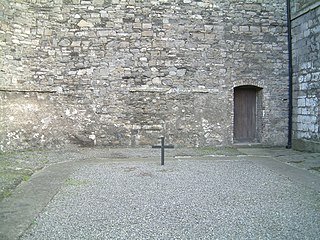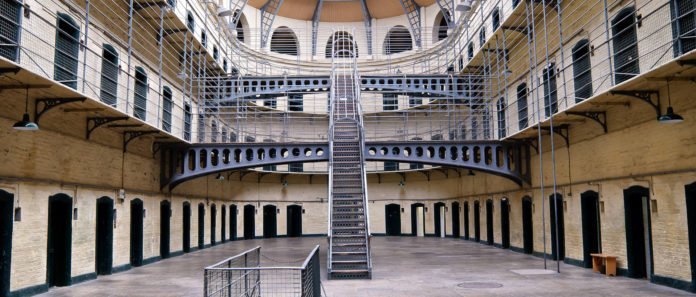Kilmainham Gaol
Kilmainham Gaol, a former jail turned museum, stands as a stark reminder of Ireland’s tumultuous history. Located in Dublin, it is one of the largest unoccupied gaols in Europe and offers visitors a deep insight into the struggles for Irish independence.
The Gaol opened its doors in 1796 and served as a prison until 1924. Throughout its operational years, it witnessed some of the most significant events in Irish history, particularly during the struggle for independence. Here’s a brief look at its past:
- Early Years:
- Initially, Kilmainham Gaol housed common criminals and political prisoners alike.
- Men, women, and even children were incarcerated within its walls under harsh conditions.
- 19th Century:
- During the Great Famine (1845-1852), the prison population surged as desperate people committed crimes to secure food and shelter within the gaol.
- Many prominent leaders of various Irish rebellions, including the Young Irelanders, were imprisoned here.
- The 1916 Easter Rising:
- Kilmainham Gaol is perhaps best known for its role in the aftermath of the 1916 Easter Rising.
- Key leaders of the rebellion, including Patrick Pearse, James Connolly, and Joseph Plunkett, were detained and executed in the gaol’s stonebreaker’s yard.
- These executions ignited public sentiment and became a pivotal moment in the fight for Irish independence.
- Closing and Restoration:
- The prison closed in 1924 and fell into disrepair.
- In the 1960s, a dedicated group of volunteers initiated its restoration, leading to its reopening as a museum in 1971.
Architecture of the Jail
Originally constructed in 1796, the prison’s design was heavily influenced by the principles of the Enlightenment, which emphasized reason, order, and progress. The architects implemented a panopticon layout, a revolutionary concept at the time. This design allowed for effective surveillance, as a single guard could monitor multiple prisoners without the inmates being aware they were being watched. This not only optimised security but also instilled a psychological sense of perpetual observation among the prisoners.
The structure’s vaulting hallways contribute significantly to its eerie ambiance. These corridors are characterised by their high ceilings and austere, stone walls, creating an imposing atmosphere. Natural light was limited, contributing to the building’s cold and harsh environment. It is worth noting the deliberate choice of minimalism in its design, reflecting the punitive philosophy of the era, which prioritised discipline and austerity.
Over the years, Kilmainham Gaol saw several modifications. Various extensions were added to the original structure, including additional cell blocks to accommodate the increasing number of prisoners during times of political upheaval, such as the Irish War of Independence. Despite these changes, the essence of the original design remained intact, maintaining its overarching principles of surveillance and control.
Visiting Kilmainham Gaol Today
Today, Kilmainham Gaol Museum offers a comprehensive look at the history of the jail and its inmates. Visitors can explore the cells, the chapel, and the infamous execution yard, all while learning about the key figures who were imprisoned here.
- Guided Tours:
- All visits to Kilmainham Gaol are conducted via guided tours, providing in-depth historical context.
- Knowledgeable guides bring the prison’s history to life, sharing stories of the prisoners and the conditions they endured.
- Exhibits:
- The museum features various exhibits, including original artifacts, letters, and photographs.
- Exhibits cover topics such as the Great Famine, the Irish War of Independence, and the Civil War.
- The Chapel:
- One of the most poignant spots in the gaol is the chapel where Joseph Plunkett married Grace Gifford just hours before his execution.
- Stonebreaker’s Yard:
- The yard where the leaders of the 1916 Easter Rising were executed is a particularly moving part of the tour.
- The crosses marking the execution spots serve as a powerful reminder of the sacrifices made for Irish independence.
How to Get to Kilmainham Gaol
It is a little out of the city centre but you can use public transport to get there:
- By Bus:
- Several Dublin Bus routes serve Kilmainham Gaol, including the 13, 40, 69, and 79.
- Check the Dublin Bus website for up-to-date schedules and routes.
- By Tram:
- The Luas Red Line tram stops at Suir Road, which is a short walk from the gaol.
- This option is particularly convenient for those traveling from the city centre.
- By Car:
- If you’re driving, there is limited on-street parking available near the gaol.
- Be mindful of parking restrictions and charges.
Kilmainham Gaol Tour Tickets
Visiting Kilmainham Gaol is very reasonably priced and tour tickets offer great value for money considering the depth of history you’ll encounter:
- General Admission Tickets:
- Adults: €8.00
- Seniors (60+): €6.00
- Students: €4.00
- Children (12-17): €4.00
- Children under 12: Free (must be accompanied by an adult)
- Family Ticket:
- Family (2 adults + up to 3 children): €20.00
- Booking in Advance:
- It is highly recommended to book your tickets in advance through the Kilmainham Gaol Museum website to secure your preferred tour time.
- Walk-up tickets are subject to availability and can sell out quickly, especially during peak tourist seasons. We find it can be difficult to secure tickets on the day.
Movies Filmed at Kilmainham Gaol
Several films have leveraged the historical and atmospheric appeal of Kilmainham Gaol. One notable example is ‘In the Name of the Father’ (1993), directed by Jim Sheridan and starring Daniel Day-Lewis. The prison scenes were pivotal in depicting the harrowing experiences of Gerry Conlon and other prisoners. Another standout film is ‘The Italian Job’ (1969), where the gaol scenes added a touch of realism to the heist film. Michael Collins (1996), The Escapist (2006), and Paddington 2 (2017) also had scenes shot there. The TV series ‘Rebellion’ (2016) featured the gaol prominently, using it to depict scenes from the 1916 Easter Rising.

- Ghost Stories:
- The jail is reputed to be haunted, with numerous reports of paranormal activity.
- Visitors and staff have claimed to hear mysterious footsteps, voices, and even apparitions of former inmates!
- Artistic Connections:
- Grace Gifford, who married Joseph Plunkett in the gaol, was a talented artist and cartoonist.
- Her poignant story is part of the history that the museum highlights. She was immortalised in the song ‘Grace’ by Frank and Sean O’Meara:
“As we gather in the chapel here in old Kilmainham Gaol
I think about these past few weeks, oh will they say we’ve failed?
From our school days, they have told us we must yearn for liberty
Yet, all I want in this dark place is to have you here with me”
Making the Most of Your Visit
To make the most of your visit to Kilmainham Gaol, here are a few tips:
- Arrive Early:
- Aim to arrive at least 15 minutes before your scheduled tour time.
- This allows you to check in, explore the exterior of the building, and take some photos.
- Dress Comfortably:
- Wear comfortable shoes and dress appropriately for the weather, as parts of the tour involve walking outdoors.
- Engage with the Guides:
- The guides are extremely knowledgeable and passionate about the history of the gaol.
- Explore the Surroundings:
- After your tour, take some time to explore the surrounding area, including the nearby Irish Museum of Modern Art (IMMA) and the beautiful Kilmainham Courthouse.
Kilmainham Gaol is a window into Ireland’s past. The stories of struggle, sacrifice, and resilience that echo through its walls are a testament to the spirit of the Irish people who fought for independence. Whether you’re a history buff, a curious traveler, or someone seeking an insight with Ireland’s heritage, a visit to Kilmainham Gaol is an experience to remember.
Kilmainham Gaol should be right at the top of your Dublin itinerary. So, book your tickets, prepare for a journey through time, and discover the stories that shaped a nation.
See Kilmainham Gaol for more.


